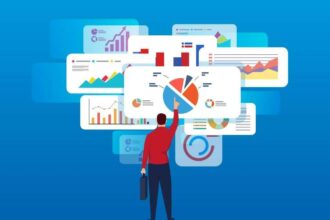It’s hard to overestimate the value that data insights have come to represent to today’s businesses. Investments in analytics tech have risen commensurately, with some 73 percent of respondents telling IDC that they expect to spend more on data-focused software than any other category in 2023.
While emphasizing data analytics has become the standard for the business community as a whole, smaller teams are often the exception. Small business owners are still prone to see business intelligence as a luxury that they can’t afford, as it requires employing data specialists to manage dedicated data repositories, data consolidation and ongoing coded queries – all of which is a non-starter for organizations where each team member is required to wear so many hats.
There are encouraging signs, however, that this sentiment is on its way out, and with a recession looming, small business leaders are going to need data insights to help optimize their strategies.
Many specialized data tools are now available as self-service web apps, making enterprise-grade data software more affordable and circumventing the need for dedicated servers. The expertise barriers have also been lowered, with onboarding rendered simple and quick – today, even non-data experts can set themselves up and make data-based strategic decisions on an ongoing basis.
With a better understanding of what the advantages analytics bring, small business owners are finally getting started with business intelligence.
Consolidating Information
Analytics gives business owners an accurate picture of the state of their ventures. Fortunately, businesses are likely already gathering data from the various business apps they use. All this information can be imported to analytics tools for processing.
Modern business intelligence platforms can integrate with hundreds of data sources like marketing communication tools, ecommerce platforms and payment providers to create this holistic picture. Business leaders can then consolidate whatever performance metrics matter most to them into dedicated interactive dashboards and dynamic reports.
Businesses that use cross-functional management suites can also explore their built-in analytics tools. Business management app vcita, which allows small teams to handle client relationship management, payment collection, appointment booking and marketing activity under one platform, uses Google’s Looker BI software to generate reports from specific operational areas that already flow through the app.
For example, a service business owner can examine their appointment conversion data to check which services are the most popular or how many customers follow through with each booking. By analyzing these specific areas of the business, entrepreneurs can readily spot issues and implement improvements.
Visualizing Trends and Extrapolating Predictions
Traditionally, it takes a certain level of specialized expertise and experience to make sense of raw numbers. What makes analytics accessible to most people is visualization. Modern tools can readily create charts and graphs to help users spot trends from their data.
The only thing that small business owners have to do is integrate their apps with visualization tools. The cloud version of Tableau, for instance, allows non-technical team members to use native “connectors” to import data sources like Salesforce, QuickBooks and Amazon Seller Central, helping merchants visualize data based on historical sales figures.
By plotting line charts of monthly sales for products, it’s possible to identify peak seasons and top-performing items. These insights can then be used as the basis for promotions and marketing campaigns.
Analytics can also be predictive. Through machine learning, even basic tools can crunch historical data and provide predictions readily. Combined with visualization, analytics can help owners of even the smallest businesses to plan for the immediate future, like increasing inventory to prevent stockouts during peak sales.
Performing Analysis in Natural Language
Analytics platforms are constantly innovating to further lower barriers to entry. Developers use effective usability design and artificial intelligence so that non-experts can perform data analysis capably.
By applying artificial intelligence, platforms can allow users to use natural language to interact with analytics platforms. Intelligence platform Phrazor, for example, allows for queries to be phrased using simple questions. Keying in a question such as, “Why did my sales grow in the last six months?” can bring up sales data within the period and the possible answers to the query.
Inversely, natural language report generation is now also emerging as a standard. Alongside visualizations, reports with accompanying insights can be generated in natural language, allowing less data-savvy business owners to create easily understood reports quickly.
Making Key Decisions Using Data
According to the Small Business Administration, about two-thirds of new businesses survive in their first two years. Armed with a clear picture of the states of their companies, entrepreneurs can quickly pinpoint whether they are poised for survival or growth. They can decide which business areas to focus on to improve their standing or pivot their business if necessary.
Through analytics, business owners can base their decisions on solid information – or, at the least, validate their intuition.
While today’s business environment is volatile to say the least, specific sectors and niches are still projected to be growth industries, providing opportunities to smarter owners of small businesses. Through business analytics, small businesses can create viable strategies to navigate their respective markets and position themselves to thrive and succeed.







